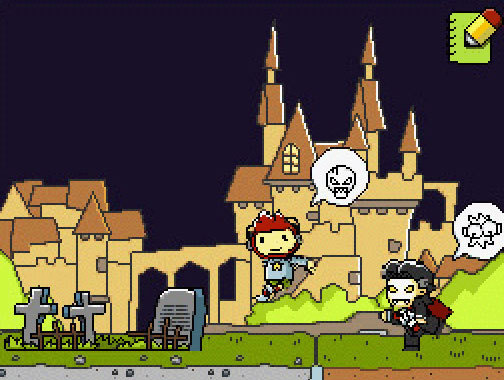Scribblenauts: Since its pre-release debut, videogame critics, developers, and fans alike have showered praise upon this new and novel creation for venturing into uncharted territory and aiming to do what no game has ever accomplished before. In some ways, Scribblenauts is a great success; its primary conceptual design elements are unarguably pioneering achievements in gaming. In other ways, however, it falters, primarily in the playability of the game it offers within the playground it establishes.
Scribblenauts, for the uninitiated, is a puzzle game that tasks players with collecting the single star from each level as they move from one to the next through a series of larger areas. There is no narrative, and the puzzles are completely independent of one another, save for a common background theme (ice, beach, mountains, etc.) in each of the locales. What makes Scribblenauts so special, though, is how one approaches these puzzles — and let me tell you, there are myriads of ways to do so — using a clever and comprehensive item system. (I suppose one could call it that.)
To interact with the game world, players call up a keyboard interface and type in any word from an expansive dictionary of well over twenty thousand nouns that can be instantly conjured into virtual existence. They may then move, rotate, and place the object/animal/person… thing… wherever they choose. The best part about this is not even the sheer number of words available for use, but the way those manifestations then interact with one another based on physical, behavioral, and relational qualities, without any further instigation from the player.
The system is a sight to behold. If you can think of it, and it isn’t offensive, copyrighted, or vulgar, then the word is most likely included. I had a great time picking out words that I deemed to be obscure, and then watching them magically appear before my eyes (although “softball” isn’t included… odd). Simply playing around on the game’s title screen, building structures, setting up chain reactions, and pitting things like Cthulhu and Shoggoth against one another in gladiatorial combat is one of the most amusing ways to play with Scribblenauts, or any game for that matter.

Unfortunately, the goal-based game itself is actually less enjoyable than the veritable sandbox of the opening scene. The two available modes are Puzzle, where certain conditions must be met in order for the stage’s star to appear (create the right items, bring characters together, eliminate antagonists, etc.), and Action, where the star is already present, but must be retrieved by navigating a daunting environment. Either mode can end up turning into a long game of trial and error, but are oftentimes quite simplistic. The ability to review each puzzle’s initial clue would be a great help, because as the game stands now, doing so requires the player to restart the level completely.
In many instances, the game suffers from a drawback similar to that of the equally creative Crayon Physics Deluxe: players can repeatedly employ the same strategies and use the same objects to finish levels, taking the joys of exploration, discovery, and PLAY out of the equation. Faulting the game for this would be unfair, since it’s the player’s choice to solve any stage in any way imaginable, but the encouragement by the game to use as few items as possible, doling out more “ollars” (the game’s currency) for each item under “par” in a way punishes creativity and lengthy, satisfying solutions.
It’s true, just blowing through Scribblenauts can be boring. It can feel like a grind. An advanced mode, where players must complete levels three times in a row with no object duplication was a brilliant addition. It eases this feeling by pushing players to think outside of the box, but replaying the same, focused, objective-based stage over and over is still not the most enjoyable way to play a game.
Controlling the game’s leading man, Maxwell, can also be frustrating. Players move Maxwell around with the stylus, tapping in the general direction they would like him to walk, jump, fly, or climb. It is not precise at all, and this unwieldy setup is one of the biggest knocks against Scribblenauts. While playing, it’s easy to question why the developers chose to map the camera controls to the DS face buttons and leave character movement to the stylus. I obviously haven’t tried an alternative setup, where Maxwell can move and jump with the d-pad and face buttons, but it seems a more logical approach in my estimation.
Is Scribblenauts an enjoyable experience? Sure. Playing with the game’s words and objects is highly entertaining, especially with friends around to brainstorm and laugh with. But is it a good game? Well, I’m inclined to say that the majority of its entertainment value lies in the former, and the controls are pretty sub-par, but the puzzles are still acceptable in their own regard. Should you at least try it? Unequivocally, yes.

















